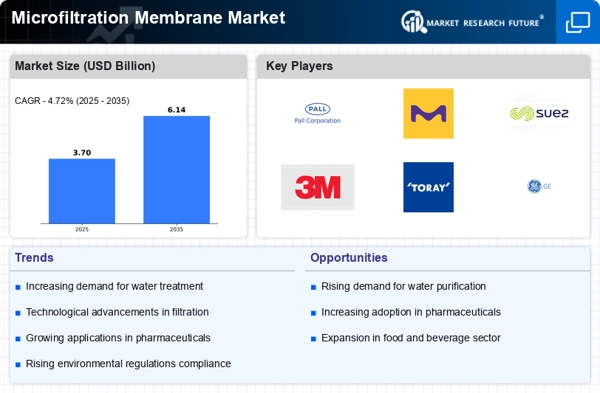Environmental Regulations
The Microfiltration Membrane Market is significantly influenced by stringent environmental regulations aimed at protecting water resources. Governments and regulatory bodies are implementing policies that mandate the treatment of wastewater and the reduction of pollutants in effluents. These regulations are compelling industries to adopt advanced filtration technologies, including microfiltration membranes, to comply with environmental standards. As a result, the market is expected to expand as companies invest in upgrading their water treatment facilities to meet these requirements. Furthermore, the emphasis on sustainable practices is driving innovation in the microfiltration sector, as manufacturers develop membranes that not only meet regulatory demands but also contribute to environmental conservation efforts. This regulatory landscape is likely to foster growth in the microfiltration membrane market, as compliance becomes increasingly critical for operational viability.
Technological Innovations
Technological advancements play a crucial role in shaping the Microfiltration Membrane Market. Innovations in membrane materials and manufacturing processes are leading to the development of more efficient and cost-effective filtration solutions. For example, the introduction of polymeric membranes with enhanced permeability and selectivity is improving performance in various applications. Additionally, the integration of smart technologies, such as IoT and automation, is streamlining operations and enhancing monitoring capabilities in filtration systems. These advancements not only improve the efficiency of microfiltration processes but also reduce operational costs for end-users. As technology continues to evolve, it is likely that the microfiltration membrane market will witness increased adoption rates, further solidifying its position in the water treatment and industrial sectors.
Rising Demand for Clean Water
The increasing global population and urbanization have led to a heightened demand for clean water, which is a primary driver for the Microfiltration Membrane Market. As water scarcity becomes a pressing issue, municipalities and industries are investing in advanced filtration technologies to ensure safe drinking water. The market for microfiltration membranes is projected to grow significantly, with estimates suggesting a compound annual growth rate of over 10% in the coming years. This growth is largely attributed to the need for effective water treatment solutions that can remove contaminants and pathogens, thereby enhancing public health and safety. Furthermore, the adoption of microfiltration membranes in wastewater treatment processes is gaining traction, as industries seek to recycle and reuse water, further propelling the market forward.
Industrial Applications and Growth
The Microfiltration Membrane Market is experiencing substantial growth due to its diverse applications across various industrial sectors. Industries such as food and beverage, pharmaceuticals, and biotechnology are increasingly utilizing microfiltration membranes for processes like clarification, sterilization, and separation. For instance, in the food and beverage sector, microfiltration is employed to enhance product quality and extend shelf life by removing unwanted microorganisms. The pharmaceutical industry also relies on these membranes for the purification of active ingredients. As these industries expand, the demand for efficient and reliable filtration solutions is expected to rise, driving the microfiltration membrane market. Market analysts project that the industrial segment will account for a significant share of the overall market, indicating a robust growth trajectory in the coming years.
Growing Awareness of Health and Safety
The rising awareness of health and safety concerns among consumers is a pivotal driver for the Microfiltration Membrane Market. As public consciousness regarding water quality and safety increases, there is a growing demand for effective filtration solutions that can ensure the removal of harmful contaminants. This trend is particularly evident in residential water treatment systems, where consumers are seeking reliable products that guarantee safe drinking water. Additionally, industries are recognizing the importance of maintaining high standards of hygiene and safety in their processes, further fueling the demand for microfiltration membranes. Market Research Future indicates that the residential segment is likely to witness substantial growth, as households invest in filtration systems to safeguard their health. This heightened focus on health and safety is expected to propel the microfiltration membrane market forward, as both consumers and industries prioritize quality and safety in their water sources.


















Leave a Comment